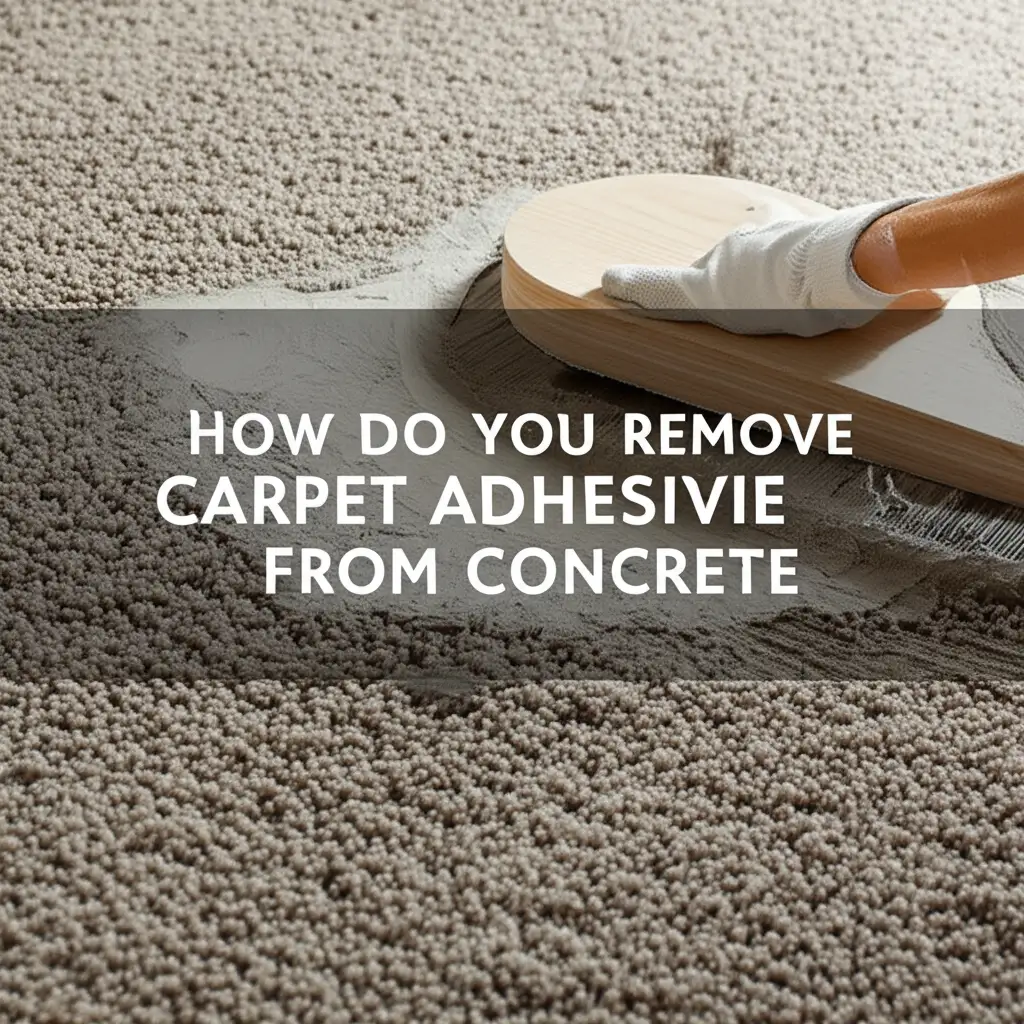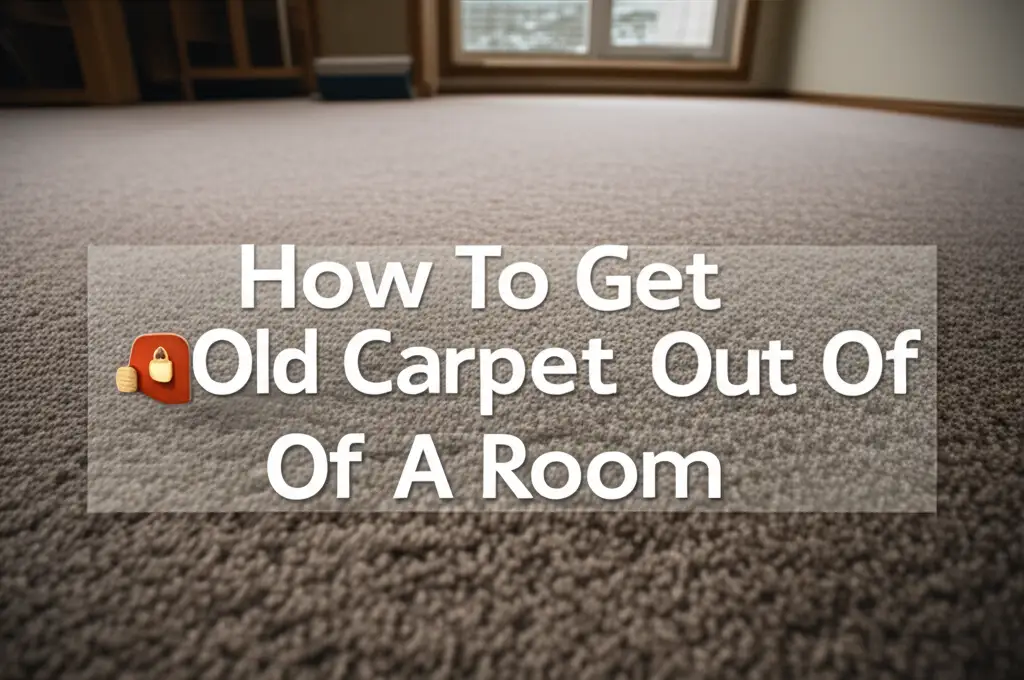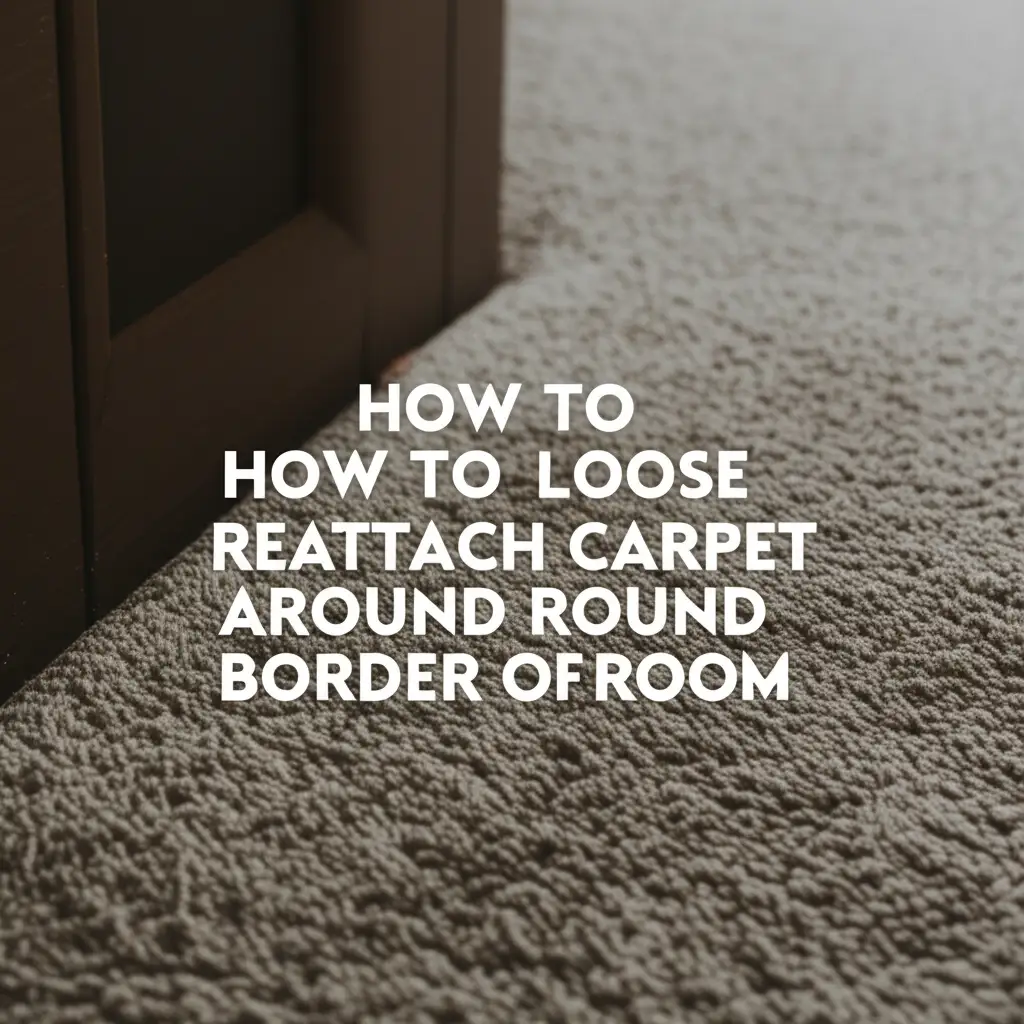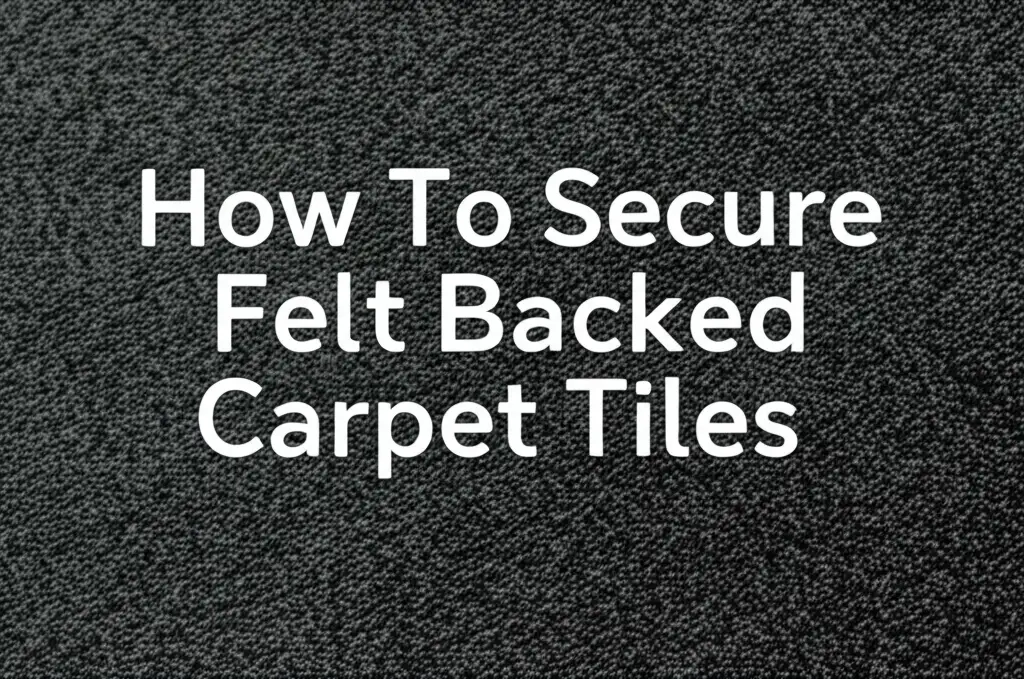· Liora Benning · Home Improvement · 14 min read
How Do You Remove Carpet Adhesive From Concrete

Mastering Carpet Adhesive Removal from Concrete
Removing old carpet can feel like a triumph. Then you see it: that sticky, crusty, stubborn layer of carpet adhesive glued firmly to your concrete floor. You might wonder, “How do you remove carpet adhesive from concrete?” This adhesive often presents a significant challenge. It prevents you from installing new flooring or simply enjoying a clean concrete surface.
I understand the frustration. I have faced many concrete floors covered in this sticky mess. This article will show you effective strategies for removing carpet adhesive from concrete. We will explore various methods, from manual scraping to chemical solutions and power tools. My goal is to equip you with the knowledge to achieve a clean concrete floor. Let’s get started on transforming your space.
Takeaway:
- Always prioritize safety with proper personal protective equipment.
- Choose the removal method that fits your adhesive type and floor condition.
- Prepare the area well before you begin any work.
- Thoroughly clean the concrete after adhesive removal.
Removing carpet adhesive from concrete involves various methods. You can use manual scraping for light residue. Heavy-duty adhesives may require chemical removers, heat guns, or power tools like grinders. Proper safety gear is crucial for any method you choose.
What Makes Carpet Adhesive So Stubborn?
Carpet adhesive sticks strongly to concrete. Manufacturers design it for a long-lasting bond. They want the carpet to stay put for years. This strong bond makes removal difficult.
Adhesives come in different types. Each type has unique properties. Water-based adhesives are often easier to remove when fresh. Solvent-based adhesives are much tougher. They create a very strong, permanent bond.
Mastic is another common type. It is a thick, tar-like substance. Mastic often appears black or dark brown. It is exceptionally challenging to remove. The type of adhesive affects your removal method. Knowing your adhesive helps you choose the right tools.
Over time, adhesives can change. They become brittle or even harder. Exposure to moisture or temperature changes impacts them. This aging makes the adhesive even more stubborn. You will need persistence and the right approach.
Safety First: Essential Gear for Adhesive Removal
Safety is not optional when removing carpet adhesive. Concrete work creates dust. Adhesives may contain chemicals. You must protect yourself from these hazards.
Wear personal protective equipment (PPE). Eye protection is critical. Dust and debris can fly into your eyes. Use safety glasses or goggles. They shield your eyes from particles.
Protect your hands with gloves. Chemical-resistant gloves are best for solvents. Heavy-duty work gloves protect against scrapes. Ensure the gloves fit well. This prevents accidents.
A respirator or dust mask is a must. Fine dust particles can harm your lungs. Chemical fumes are also dangerous. Choose a mask rated for dust and vapors. This protects your respiratory system.
Ventilation is also important. Open windows and doors in the work area. Use fans to move air out. Good airflow reduces fume buildup. It also helps dust settle less. Protect your hearing, too. Grinders and other power tools are loud. Wear earplugs or earmuffs. This prevents hearing damage over time.
Preparing Your Concrete Slab for Adhesive Removal
Before you tackle the adhesive, you must prepare the area. Good preparation saves time. It also makes the job safer. Clear everything from the room. Remove all furniture, decorations, and other items. You need a completely empty space. This gives you room to work.
Next, remove any remaining carpet or padding. Pull up all the fabric. Cut it into manageable strips. Dispose of the old carpet properly. Some pieces may still cling to the adhesive. Don’t worry about those small bits now. The main goal is to clear the large material.
Inspect the concrete floor. Look for any large debris or loose adhesive pieces. Scrape away anything easy to remove. Use a flat shovel or a sturdy scraper for this. A broom can help clear small bits. A vacuum cleaner with a strong filter is also useful. It picks up fine dust.
Test a small, hidden area first. This helps you choose the best method. Some adhesives respond better to heat. Others dissolve with chemicals. A small test prevents damage to your entire floor. It also confirms your chosen method works. Your concrete floor is now ready for adhesive removal.
Mechanical Methods: Scraping and Grinding Away Adhesive
Mechanical methods remove adhesive physically. They are often the first choice for tough jobs. These methods use tools to scrape or grind the adhesive off. They work well for thick layers.
Manual Scraping Techniques
Manual scraping is a simple method. It works for thin or brittle adhesive layers. You need a strong, sharp floor scraper. Push the scraper under the adhesive. Apply firm, steady pressure. Angle the blade slightly. This helps lift the adhesive without gouging the concrete.
For very tough spots, a hammer and chisel can help. Use a wide chisel. Tap it gently with the hammer. This breaks up stubborn adhesive. Be careful not to damage the concrete. Keep your scraper blade sharp. A dull blade makes the job harder. It also takes longer. You can sharpen the blade with a file.
Scraping can be hard work. It is physically demanding. Take breaks as needed. This method is good for smaller areas. It avoids chemicals. It also produces less dust than grinding.
Power Tool Solutions
Power tools make adhesive removal faster. They are ideal for large areas or thick adhesive. A floor grinder is a powerful option. It uses rotating abrasive pads. These pads grind away the adhesive. Grinders come in different sizes. Some are walk-behind models for large spaces. Others are handheld for smaller jobs.
Rent a floor grinder from a tool rental store. Ask for diamond-tipped grinding cups. These are very effective on adhesive. Use a dust shroud with the grinder. Connect it to a powerful vacuum. This controls dust significantly. Power tools can create a lot of dust.
Another tool is a rotary hammer with a chisel bit. This tool vibrates the adhesive. It helps break its bond with the concrete. It is more aggressive than a manual scraper. It works well for extremely thick or hardened adhesive.
Power tools require caution. Follow all safety instructions. Wear full PPE, including hearing protection. Operate the tools slowly and carefully. Let the tool do the work. Do not force it. Using power tools correctly leads to efficient removal. It leaves your concrete ready for the next step.
Chemical Solutions: Effective Adhesive Removers
Chemical removers break down the adhesive bond. They are a good option when mechanical methods fail. Or, they can help soften the adhesive before scraping. Always read the product label carefully.
Choosing the Right Chemical
Many types of chemical removers exist. Some are solvent-based. These contain strong chemicals like mineral spirits or acetone. They work by dissolving the adhesive. They are effective but emit strong fumes. Others are citrus-based or soy-based. These are “green” alternatives. They have fewer fumes and are safer for the environment. However, they may take longer to work.
Mastic removers are specific for black mastic. They are very strong chemicals. Always choose a remover designed for the type of adhesive you have. Check if it is safe for concrete. Some strong chemicals can etch or discolor the concrete. Test the product in a small, hidden area first. This confirms it will not harm your floor.
Applying Chemical Removers Safely
Apply chemical removers carefully. Pour a generous amount over the adhesive. Spread it with a squeegee or roller. Make sure the adhesive is fully covered. Follow the manufacturer’s instructions for dwell time. This is how long the chemical needs to sit. It can range from 15 minutes to several hours.
Keep the area well-ventilated during application. Open windows and use fans. Wear your respirator, gloves, and eye protection. Chemical fumes can be harmful. After the dwell time, the adhesive should be soft. It will be much easier to scrape away. Use a sturdy floor scraper.
Scrape the softened adhesive into piles. Dispose of it according to local regulations. Some chemical-soaked waste is hazardous. After scraping, clean the floor. Use a cleaner specified by the chemical remover’s manufacturer. This neutralizes any remaining chemicals. It also removes residues. A clean rinse is often needed. For general concrete cleaning tips after your project, you can refer to our guide on how to clean concrete sidewalk.
Heat-Based Approaches: Softening the Bond
Heat is a simple, effective way to loosen adhesive. It makes the glue pliable. Once soft, it is easier to scrape off the concrete. This method works well for many types of carpet adhesive.
A heat gun is a common tool for this. Point the heat gun at a small section of adhesive. Move it slowly over the area. Watch for the adhesive to bubble or soften. It will become gooey. Do not hold the gun in one spot too long. This can burn the adhesive or damage the concrete.
As the adhesive softens, quickly scrape it away. Use a heavy-duty floor scraper. Work in small sections. This ensures the adhesive stays soft while you scrape. Reapply heat as needed. Heat guns get very hot. Use caution to avoid burns. Wear heavy work gloves.
A steam cleaner can also work. Steam delivers moist heat. This helps soften water-soluble adhesives. It is also a good option for general cleaning after removal. Direct the steam nozzle at the adhesive. Let the steam penetrate. Then, scrape immediately. Steam is less aggressive than a heat gun. It is safer for your concrete.
Heat methods are fume-free. They do not introduce new chemicals. They can be slow for very large areas. However, for stubborn spots, they are very effective. They loosen even the toughest bonds. Combining heat with scraping works powerfully. It makes sticky jobs much easier.
Natural and Alternative Methods for Lighter Residue
Not all adhesive removal requires harsh chemicals or power tools. For lighter adhesive residue, you can try natural or alternative methods. These options are often safer and gentler on your concrete. They are also better for the environment.
Hot water is surprisingly effective on some water-soluble glues. Pour very hot water over a small section of adhesive. Let it soak for 15-20 minutes. The hot water softens the glue. Then, use a stiff brush or a floor scraper. Scrub or scrape the softened adhesive away. You may need to repeat this process several times. This method works best for older, dried-out water-based adhesives.
Vinegar is another natural option. White vinegar is mildly acidic. It can help break down some glues. Mix equal parts white vinegar and hot water. Apply the solution to the adhesive. Let it sit for about 30 minutes. Then, scrub with a brush. This method is typically slower than hot water alone. It is more effective on lighter, less stubborn residues.
For very light, tacky films, rubbing alcohol can sometimes help. Apply a small amount to a clean cloth. Rub the sticky residue firmly. The alcohol helps dissolve the tackiness. This is not for thick layers of adhesive. It works only on superficial stickiness.
These methods are low-cost and low-fume. They are good for a first attempt. If the residue is thick or stubborn, you will need stronger methods. However, for a simple clean-up, they are worth trying. Remember, patience is key with natural solutions.
While these methods are aimed at concrete, the principle of softening and scraping is sometimes applied to other surfaces with similar adhesive issues. For example, removing carpet tape from wood floors also involves softening the adhesive before scraping, although the methods and tools differ significantly due to the surface type. See our guide on how to remove carpet tape from wood floor for insights on wood surfaces.
Post-Removal Cleanup: Achieving a Pristine Surface
After you remove the bulk of the adhesive, your job is not quite done. You must clean the concrete thoroughly. This final step ensures a pristine surface. It prepares the floor for whatever comes next.
First, remove all loose debris. Sweep up any scraped adhesive bits. Use a heavy-duty shop vacuum. It picks up dust and small particles. Ensure the vacuum has a good filter. Fine dust can clog regular vacuum filters.
If you used chemical removers, neutralize them. Some chemicals leave a residue. This residue can affect new flooring. Follow the chemical product’s instructions for neutralization. Often, this involves rinsing with water. Sometimes, a mild detergent solution is needed. Rinse the floor multiple times. Use a squeegee to push the water to a drain. Let the concrete dry completely.
For general cleaning, a degreaser or concrete cleaner works well. Mix it according to the label. Apply it to the floor. Scrub with a stiff brush or a floor scrubber machine. This removes any remaining grime or adhesive film. Rinse the floor well after scrubbing. This final cleaning prepares your concrete.
A perfectly clean concrete floor is ready for anything. You might want to leave it bare. You could apply a sealer. Or, you might install new flooring. A properly prepared floor ensures your next project lasts. If you plan to put new carpet over a concrete floor, especially in a basement, consider how to sealing basement concrete floor before carpet to prevent moisture issues.
Conclusion
Removing carpet adhesive from concrete is a challenging task. However, it is entirely manageable with the right approach. We explored various methods to help you achieve a clean floor. You learned about preparing the area and prioritizing safety. We covered mechanical scraping and powerful grinding. We also discussed chemical solutions and heat-based techniques. Natural methods for lighter residue were also highlighted.
Each method has its strengths. The best choice depends on your adhesive type and the project size. Always start with the least aggressive method. Then, move to stronger options if needed. Remember to wear appropriate safety gear at all times. Protect your eyes, hands, and lungs. Ensure good ventilation in your workspace.
A clean concrete floor offers many possibilities. You can stain it, polish it, or cover it with new flooring. Take your time with each step. Patience leads to the best results. You now have the knowledge to confidently remove stubborn carpet adhesive from concrete. Your concrete floor is ready for its new life. Go ahead and transform your space!
FAQ Section
Q1: How long does it take to remove carpet adhesive from concrete?
A1: The time it takes varies greatly. It depends on the adhesive type, its age, and the area size. A small room with old, brittle adhesive might take a few hours. A large area with tough mastic could take several days. Using power tools often speeds up the process significantly.
Q2: What is the easiest way to remove carpet adhesive from concrete?
A2: There is no single “easiest” way; it depends on the adhesive. For light residue, hot water and scraping can be easy. For thick, stubborn glue, a chemical adhesive remover followed by scraping is often most effective. Power grinding with a specialized machine makes large jobs easier but requires more equipment.
Q3: Can I paint over old carpet adhesive on concrete?
A3: No, it is not advisable to paint over old carpet adhesive. Paint will not adhere well to the sticky or uneven surface. The adhesive can bleed through the paint over time. This leads to an unprofessional finish. You must remove all adhesive for proper paint adhesion and a smooth result.
Q4: Will vinegar remove carpet adhesive from concrete?
A4: Vinegar can help remove very light, water-soluble carpet adhesive residue. Mix it with hot water and let it soak. However, vinegar is generally not strong enough for thick layers or solvent-based adhesives. For tough jobs, you will need stronger mechanical or chemical removers.
Q5: What kind of grinder do you use to remove carpet adhesive?
A5: You typically use a concrete grinder or floor grinder. These machines are often rented from equipment supply stores. They use abrasive grinding discs, often diamond-tipped. A dust shroud attached to a strong vacuum is essential to manage the dust created during grinding.
Q6: Can boiling water remove carpet adhesive from concrete?
A6: Boiling water can soften some water-soluble adhesives. Pour it carefully over the adhesive and let it sit for a few minutes. Then, scrape the softened glue. Be cautious as boiling water can cause burns. This method works best for certain adhesive types and lighter residue, not all.





